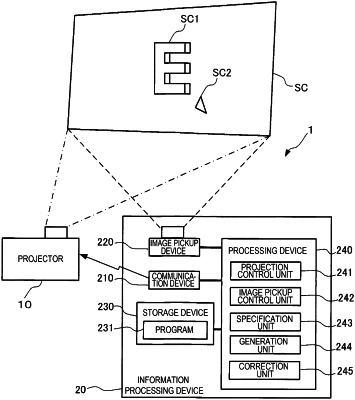| CPC H04N 9/3185 (2013.01) [G03B 21/147 (2013.01)] | 11 Claims |

|
1. A projection method comprising:
projecting, by a projector, a first image onto a projection target object before projecting a projection image;
storing a first picked-up image of the projection target object in a state where the first image is projected, picked up by an image pickup device;
determining a first correspondence between a projector coordinate system and a camera coordinate system, the projector coordinate system being a coordinate system of an image that is projected by the projector on the projection target object, the camera coordinate system being a coordinate system of an image that is picked-up by the image pickup device from the projection target object, the projector coordinate system representing a position on the image projected by the projector, the camera coordinate system representing a position on the image picked up by the image pickup device, the first correspondence being determined based on the first picked-up image and the first image;
projecting, by the projector, a second image onto the projection target object in response to reception of a control signal representing occurrence of a change in a positional relationship between the projector and the projection target object;
storing a second picked-up image of the projection target object in a state where the second image is projected, picked up by the image pickup device;
determining a second correspondence between the projector coordinate system and the camera coordinate system, based on the second picked-up image and the second image;
generating correction information representing an amount of correction corresponding to the change in the positional relationship, based on one or a plurality of first feature points in a third image acquired by converting the first picked-up image into the projector coordinate system, based on the first correspondence, and one or a plurality of second feature points corresponding to the one or plurality of the first feature points, in a fourth image acquired by converting the second picked-up image into the projector coordinate system, based on the second correspondence; and
projecting, by the projector, the projection image that is corrected based on the correction information.
|